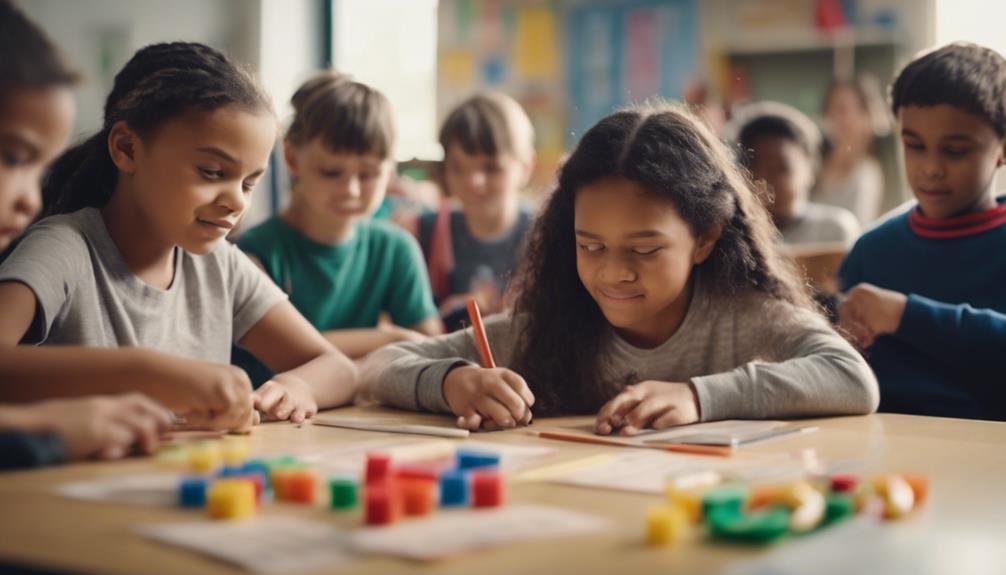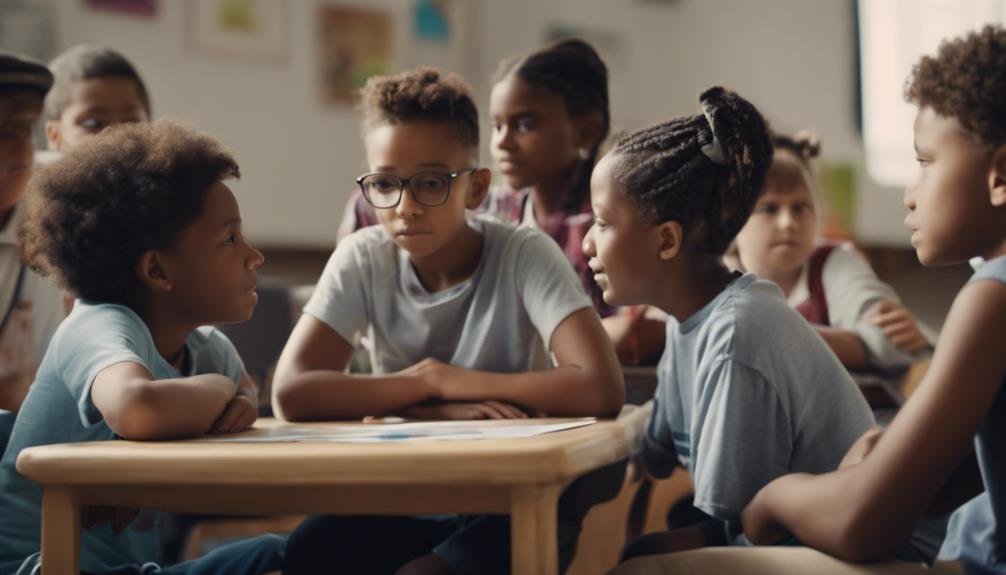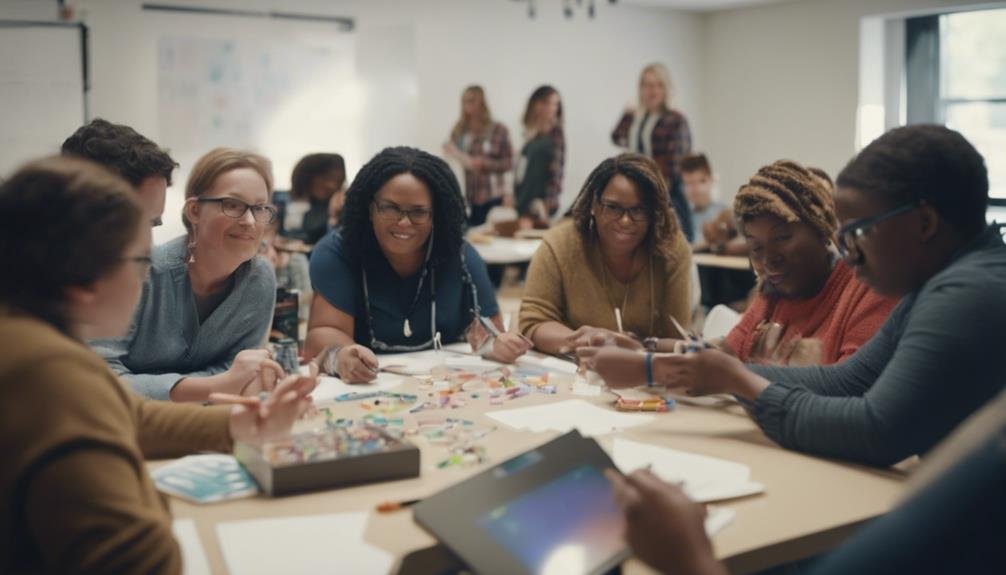"Cherishing Little Steps - A Haven for Baby and Family Journeys"
Strategies for Supporting Children With Special Educational Needs
Imagine a garden where each plant requires unique care to thrive; some need more sunlight, while others crave extra water. Similarly, supporting children with special educational needs involves tailoring approaches to suit their individual requirements.
By implementing personalized education plans, fostering inclusive environments, and embracing assistive technologies, you can cultivate a nurturing ecosystem that allows every child to flourish.
But there's more to discover beyond these initial steps – deeper insights await on how to effectively collaborate and empower these remarkable individuals.
Key Takeaways
- Parental involvement enhances diagnosis accuracy and supports tailored interventions.
- Individualized Education Plans (IEPs) track progress and address specific needs effectively.
- Inclusive classrooms cater to diverse learning styles and promote social interaction.
- Assistive technology integration and support networks enhance learning opportunities and social skills development.
Understanding Special Educational Needs

If you're a parent or educator, understanding special educational needs can make a significant difference in how you support children. The diagnosis process can sometimes be overwhelming, but your involvement is key. As a parent, your observations and insights play an essential role in helping professionals understand your child's unique needs. Your active participation in assessments and meetings can provide valuable information that contributes to an accurate diagnosis.
Parental involvement not only supports the diagnosis process but also guarantees that interventions are tailored to meet your child's specific requirements. Your input helps create a thorough picture of your child's strengths and challenges, guiding educators in developing effective strategies to support their learning and development. Remember, you're an important part of the team working to help your child succeed.
Individualized Education Plans (IEPs)
Crafting an Individualized Education Plan (IEP) involves collaboratively outlining specific goals and strategies to support your child's unique learning needs. Your active participation in the IEP process is essential. It helps that the plan is tailored to address your child's specific strengths and challenges. Through parent involvement, you can provide valuable insights into your child's learning preferences and areas where they may need additional support. Regular updates on student progress will help gauge the effectiveness of the strategies outlined in the IEP.
| Strategies for IEP | ||
|---|---|---|
| Parent Involvement | Collaborate with teachers | Provide insights into your child's learning preferences |
| Teacher Collaboration | Work together for student success | Implement effective teaching strategies |
| Learning Accommodations | Tailor learning to your child's needs | Provide necessary support for academic growth |
Inclusive Classroom Practices

To promote an inclusive learning environment, educators should incorporate diverse teaching methods and encourage collaboration among students of all abilities. By implementing differentiated instruction, teachers can tailor their lessons to meet the unique learning needs of each student. This approach allows for individualized support while ensuring that all students are challenged at appropriate levels. Classroom accommodations, such as providing visual aids or preferential seating, can also help create a more inclusive space where every child feels valued and supported.
Essential support plays a vital role in fostering inclusivity within the classroom. Encouraging students to work together not only promotes social interaction but also allows for the sharing of knowledge and skills. Additionally, utilizing universal design principles when planning lessons and activities can benefit all learners by making materials and resources accessible to everyone.
Assistive Technology Integration
Integrating assistive technology into classroom practices can enhance learning opportunities for students with special educational needs. By incorporating technology tools and accessibility features, you can create a more inclusive and supportive learning environment. Here are some ways you can effectively integrate assistive technology:
- Utilize learning apps: Introduce interactive learning apps tailored to individual student needs. These apps can provide personalized learning experiences and help students engage with the material more effectively.
- Explore communication devices: Communication devices such as speech-to-text software or augmentative communication tools can empower students to express themselves more confidently. These devices can also facilitate better interaction with peers and teachers.
- Customize accessibility features: Take advantage of accessibility features on devices to accommodate various learning styles and challenges. Adjust font sizes, use voice commands, or enable screen readers to make certain all students can access and engage with educational content seamlessly.
Building Strong Support Networks

Building strong support networks is essential for creating a nurturing environment for children with special educational needs. Peer support plays an important role in helping these children feel included and understood. Encouraging friendships and social interactions within the classroom can boost their confidence and overall well-being.
As a parent, your involvement is equally important. By actively participating in school activities, communicating with teachers, and attending parent-teacher meetings, you can stay informed about your child's progress and advocate for their needs effectively.
Creating a strong support network also involves collaborating with therapists, counselors, and special education professionals. These individuals can offer valuable insights and strategies to support your child's unique requirements. Additionally, connecting with other parents facing similar challenges can provide a sense of community and shared experiences.
Sensory Integration Strategies
As you navigate ways to best support your child with special educational needs, exploring sensory integration strategies can play a pivotal role in enhancing their learning experience and overall well-being. Sensory regulation is essential for children with special educational needs to feel comfortable and engaged in their environment.
Here are some integration techniques to contemplate:
- Sensory Diet: Creating a personalized sensory diet can help your child regulate their sensory input throughout the day, improving focus and behavior.
- Sensory-Friendly Environment: Designing a sensory-friendly space at home or in the classroom can reduce sensory overload and promote a sense of calm.
- Sensory Breaks: Encouraging regular sensory breaks during learning activities can prevent sensory overwhelm and support better attention and participation.
Positive Behavior Support Techniques

To effectively support your child with special educational needs, implementing positive behavior support techniques can greatly enhance their learning journey and overall well-being. When it comes to behavior management, using reinforcement techniques is key in promoting positive behaviors. By focusing on reinforcing desired behaviors rather than solely punishing negative ones, you create a more supportive and encouraging environment for your child.
| Reinforcement Techniques | Description |
|---|---|
| Positive Reinforcement | Rewarding desired behaviors with praise, tokens, or privileges. |
| Negative Reinforcement | Removing a negative stimulus when a desired behavior is displayed. |
| Extinction | Ignoring behaviors that are seeking attention to discourage them. |
These techniques aim to create a positive atmosphere where your child feels motivated and supported in their learning process. Remember, every child is unique, so it may take some time to find the most effective approach for your child. Consistency and patience are key as you work towards promoting positive behaviors and overall growth.
Collaborating With Special Educators
When collaborating with special educators, remember to openly communicate your child's needs and strengths to guarantee a tailored and effective support plan. Effective communication is key to ensuring that everyone involved is on the same page and working towards common goals.
Collaboration with special educators brings many benefits, including gaining access to their expertise and experience in supporting children with special needs. Here are three essential tips for successful collaboration:
- Be Open and Honest: Share your child's challenges and successes openly with special educators to create a thorough support plan.
- Listen Actively: Take the time to listen to the input and suggestions of special educators, as they bring valuable insights to the table.
- Work Together: Approach collaboration as a partnership, working together with special educators to provide the best possible support for your child.
Encouraging Self-Advocacy Skills

Encourage your child to develop self-advocacy skills by empowering them to express their needs and preferences confidently. Self-advocacy empowerment is essential for your child to navigate the educational system effectively. Help them practice communication skills development by encouraging them to articulate their requirements to teachers and peers. Building confidence is a gradual process, so offer continuous support and positive reinforcement along the way. Celebrate small victories and provide constructive feedback to aid in their growth.
Independence fostering is key in nurturing self-advocacy skills. Encourage your child to take ownership of their education by attending meetings with educators and actively participating in discussions about their needs. Provide them with opportunities to make choices and decisions regarding their learning whenever possible. Remember, self-advocacy is a skill that develops over time with practice and encouragement. Be patient and understanding as your child learns to advocate for themselves, and celebrate their progress no matter how small it may seem.
Cultivating Empathy and Understanding
As your child learns to express their needs confidently, fostering empathy and understanding in their interactions with others becomes a valuable aspect of their growth and development. Developing empathy is an important skill that can greatly benefit your child's social interactions and relationships.
Here are some strategies to help nurture empathy development and foster understanding:
- Model Empathetic Behavior: Demonstrate empathy in your own interactions and highlight the importance of understanding others' feelings.
- Encourage Perspective-Taking: Encourage your child to think about situations from different viewpoints to promote understanding and empathy towards others.
- Practice Active Listening: Teach your child the art of active listening, where they focus on understanding the speaker's emotions and thoughts rather than just waiting for their turn to speak.
Continuous Professional Development

To guarantee your ability to support children with special educational needs effectively, engaging in continuous professional development is essential. Professional growth through specialized training will equip you with the necessary skills and knowledge to cater to the diverse requirements of these children. Continuous learning guarantees that you stay updated on the latest research, interventions, and best practices in the field of special education.
| Benefits of Continuous Professional Development | Ways to Engage in Professional Growth |
|---|---|
| 1. Enhances your expertise in special education | 1. Attend workshops and conferences |
| 2. Improves your understanding of diverse learning needs | 2. Pursue advanced degrees or certifications |
| 3. Enables you to implement evidence-based practices | 3. Participate in online courses or webinars |
| 4. Connects you with a network of professionals in the field | 4. Engage in peer learning through professional communities |
Frequently Asked Questions
What Are Some Common Challenges Faced by Children With Special Educational Needs When Transitioning to Higher Education or the Workforce?
Moving to higher education or the workforce can be tough for you, especially if you face challenges like adapting to new environments, managing time effectively, and understanding workplace expectations. But with support, you can overcome these hurdles and build your readiness for success.
How Can Parents and Caregivers Best Support Their Child With Special Educational Needs Outside of the School Setting?
At home, focus on creating a safe space for your child with special needs. Show love and understanding through emotional support. Engage in fun learning activities and use effective communication techniques to strengthen your bond and their development.
Are There Any Specific Resources or Programs Available for Children With Special Educational Needs Who Are Also English Language Learners?
In your quest to help your bilingual child with special educational needs, seek out tailored programs that blend linguistic support with cultural sensitivity. Look for resources promoting language development through differentiated instruction.
How Can Schools Ensure That Children With Special Educational Needs Are Included in Extracurricular Activities and Social Events?
You can guarantee children with special needs are included in extracurricular activities by actively involving them in planning and adapting activities. Encourage peer relationships and provide support to overcome participation barriers, fostering social inclusion and a sense of belonging.
What Strategies Can Educators Use to Address the Intersectionality of Race, Gender, and Socioeconomic Status in Supporting Children With Special Educational Needs?
To address the intersectionality of race, gender, and socioeconomic status in supporting children with special educational needs, educators must embody cultural competence. Craft an inclusive curriculum that honors diverse identities and build robust support networks for every child's unique journey.
Conclusion
As you continue to support children with special educational needs, remember to embrace the power of collaboration and empathy. By working closely with special educators, integrating assistive technology, and fostering self-advocacy skills, you can create a nurturing environment where every child can thrive.
Keep cultivating your understanding and seek continuous professional development to stay informed and effective. Together, with a strong support network, you can provide the best possible opportunities for children with special needs to succeed.



Great info and straight to the point. I am
not sure if this is really the best place to ask but do you guys have any thoughts on where to employ
some professional writers? Thank you 🙂 Lista escape roomów
I like this blog very much, Its a real nice office to read and receive information..
Aw, this was a very good post. Taking the time and actual effort to make a top notch article… but what can I say… I procrastinate a lot and never seem to get anything done.
I could not refrain from commenting. Well written!
The next time I read a blog, I hope that it won’t disappoint me just as much as this one. I mean, Yes, it was my choice to read, however I truly thought you would have something interesting to say. All I hear is a bunch of whining about something that you could fix if you were not too busy seeking attention.
After looking at a few of the articles on your web site, I really like your technique of writing a blog. I saved as a favorite it to my bookmark webpage list and will be checking back soon. Please visit my website as well and let me know how you feel.
Good web site you have got here.. It’s difficult to find high quality writing like yours these days. I really appreciate individuals like you! Take care!!
Pretty! This was an incredibly wonderful post. Thank you for providing this info.
A fascinating discussion is definitely worth comment. I think that you ought to publish more on this subject matter, it might not be a taboo matter but generally people don’t speak about these topics. To the next! Best wishes.
Can I just say what a relief to uncover somebody who really knows what they are discussing on the internet. You actually realize how to bring a problem to light and make it important. More and more people must read this and understand this side of the story. It’s surprising you aren’t more popular since you certainly possess the gift.
Oh my goodness! Amazing article dude! Many thanks, However I am going through troubles with your RSS. I don’t know the reason why I am unable to subscribe to it. Is there anyone else having similar RSS problems? Anyone who knows the answer will you kindly respond? Thanx!!
I used to be able to find good advice from your content.
After looking at a number of the blog posts on your web page, I seriously like your way of blogging. I book marked it to my bookmark website list and will be checking back soon. Take a look at my web site too and let me know what you think.
May I just say what a relief to uncover someone that actually understands what they are talking about on the internet. You definitely know how to bring an issue to light and make it important. A lot more people ought to read this and understand this side of the story. I was surprised that you aren’t more popular since you most certainly possess the gift.
Nice post. I learn something totally new and challenging on websites I stumbleupon everyday. It will always be useful to read articles from other authors and practice something from other web sites.